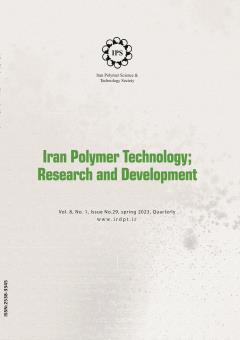A review of methods for determining contact stress in polymer base gears
Subject Areas :
1 -
Keywords: Polymer gear, contact stress, Hertz model, finite element,
Abstract :
Basically, gears are an evolved form of friction wheels that have teeth added to them to prevent slippage and ensure relative motion uniformity. The use of polymer gears is increasing due to advantages such as corrosion resistance, injection molding capability, operation without lubricants and low noise. However, the mechanical strength, thermal resistance and durability of polymer gears are lower than metal gears. The locking mechanism in metal gears is different from polymer gears. Among the important damages that lead to failure of polymer gears is thermal deformation, which does not exist in metal gears. In polymer gears, due to the viscoelastic and plastic nature of polymers, a lot of heat is generated during gear engagement and the temperature increases. An increase in temperature causes the ribs to soften and, as a result, change their shape. Pitting, fatigue and wear are other factors that lead to failure of polymer gears. The contact stress resulting from the torque applied to the gear plays the most important role in the intensity of each of the mentioned delays. Investigating the contact stress in polymer gears, including the challenges of industrialists and researchers, will provide a better understanding for the better design of these types of gears, as well as life expectancy. This research is a review of various methods for determining and checking contact stress, including Hertz numerical model, standard method and finite element method.
1. Johnson K., A Review of the Theory of Rolling Contact Stresses, Wear, 9, 4-19, 1966.
2. Dutt K.A., Soni S., Patel D., Hertzian Contact Stress Analysis in Roller Power Transmission One-way Clutch by Using Finite Element Analysis, Advanced Engineering Optimization Through Intelligent Techniques, 621-630, 2020.
3. He Y., Numerical Simulation-based Optimization of Contact Stress Distribution and Lubrication Conditions in the Straight Worm Drive, Strength of Materials, 50, 157-165, 2018.
4. Hertz H., On the Contact of Rigid Elastic Solids and on Hardness, Chapter 6: Assorted Papers, MacMillan, New York, 1882.
5. Liu, C.P., Effect of Pre-wear on the Rolling Contact Fatigue Property of D2 Wheel Steel, Wear, 442, 203154, 2020.
6. Lin Y., Zhou Z., Li K.Y., Improved Wear Resistance at High Contact Stresses of Hydrogen-free Diamond-like Carbon Coatings by Carbon/carbon Multilayer Architecture, Applied Surface Science, 477, 137-146, 2019.
7. Medina R., Deep Learning-based Gear Pitting Severity Assessment Using Acoustic Emission, Vibration and Currents Signals, 2019 Prognostics and System Health Management Conference (PHM-Paris), IEEE, 2019.
8. Wright D.H., Testing Automotive Materials and Components, Society of Automotive Engineers, 251- 254, 1993.
9. Dudley D.W., Handbook of Practical Gear Design, McGraw-Hill Book Company, 656, 1984.
10. Mohsenzadeh R., Wear and Failure of Polyoxymethylene/calcium Carbonate Nanocomposite Gears, Proceedings of the Institution of Mechanical Engineers, Part J: Journal of Engineering Tribology, 1350650119867530, 2019.
11. Li J., A Novel Method for Early Gear Pitting Fault Diagnosis Using Stacked SAE and GBRBM, Sensors, 19, 758, 2019.
12. Hassan A.R., Contact Stress Analysis of Spur Gear Teeth Pair, World Academy of Science, Engineering and Technology, 58, 597-602, 2009.
13. Mohsenzadeh R., Gear Life and Failure Mode Versus Meshing Stress in Polyacetal/carbon Black Nanocomposite Gears, Engineering Failure Analysis, 131, 105859, 2022.
14. MohsenzadehR., Development of Stress Distribution of Composite Gear Tooth Reinforced by Nano-CaCo3, Using Finite Element Analysis and its Correlation with Experience, Journal of Failure Analysis and Prevention, 1-9, 2022.
15. Sukumaran J., Modelling Gear Contact with Twin-disc Setup, Tribology International, 49, 1-7, 2012.
16. Colbourne J.R., The geometry of involute gearsm, Springer Science & Business Media, 173-197, 2012.
17. Litvin F.L., and Alfonso F., Gear geometry and applied theory, Cambridge university press, 251-253, 2004.
18. Mohsenzadeh R., Soudmand B., and Shelesh-Nezhad K., Failure Analysis of POM Ternary Nanocomposites for Gear Applications: Experimental and Finite Element Study, Engineering Failure Analysis, 140, 106606, 2022.
19. Mohsenzadeh R., Soudmand V., Shelesh-Nezhad K., A Combined Experimental-numerical Approach for Life Analysis and Modeling of Polymer-based Ternary Nanocomposite Gears, Tribology International, 107654, 2022.
20. Mohsenzadeh R., Analysis and Stress Distribution in Polymer Gears, Iran Polymer Technology, Research and Development, 2, 71-77, 1399.
21. Li W., An Investigation on the Wear Behaviour of Dissimilar Polymer Gear Engagements, Wear, 271, 2176-2183, 2011.

